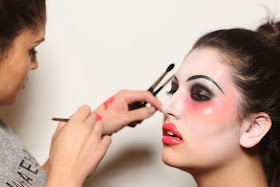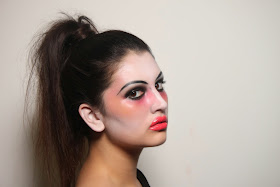I am exceptionally pleased with the skills I have learnt on
this project. I feel that I have learnt a lot more technical skills, and honed
some technical skills from last year that I wasn’t very confident with. I have
also gained a lot more experience about working in the industry, in terms of
discussing designs and executing someone else’s design and doing a good job
purely based on your own skills and not what you think looks pretty in your own
head.
I have learned so much about Weimar Berlin, which I am now
embarrassed to say I didn’t even know existed. All the history I knew about
Germany centred so much around WWII and Hitler, I never really thought about
what Germany was like before that. I’m amazed at how open it was and how, much
it relates to present day in terms of their openness of sexuality, expressing
who they were as well as certain negative points such as the state of economic
crisis and what people will do when money is a problem. I really enjoyed
researching into Weimar culture and it is something I would like continue
researching and referencing in projects to come, including non-university
related ones.
When it came to creating my historical character, I found it
quite tricky at times as it needed to look completely historical so I found it
quite hard to come up with a look that didn’t look boring and the same as
everyone else’s. When it came to the actual research and creation however, I
found that working through the 11 Stanislavski posts really helped with working
out what my perception of Fraülein
Kost was. I enjoyed working through keywords and translating these into my
design, although looking back now, I feel I could have looked a little more
into this. I have definitely taken it on board as a learning curve however, so
next term I will work harder on this aspect of designing.
I am exceptionally pleased with how my Contemporary design
turned out. I had initially come up with a different idea, but when my model
cancelled on my last minute, I was forced to come up with a new design. I am so
glad this happened. I came up with my new design the night before I had to
present it, and got a true taste of how faced things move in the industry. I
went in a completely different direction, not only to my first design, but also
to how I normally go. I truly stepped out of my comfort zone and I am so happy
with the results. I feel like I utilised a lot of the skills we learnt in
Lottie’s lesson and it forced me to thing creatively and look at all sorts of
references and inspiration that I wouldn’t look at. Next time, I would like to
get a little more experimental with the hair however. I am happy with it for
the purpose of this look, as I wanted the makeup to be the main focus, but next
term I would like to get more creative with my hair styling.
All in all, I am happy with my progression this term. It may
have been a little delayed, but I definitely feel a lot more confident as a
makeup artist and designer!







































.jpg)












